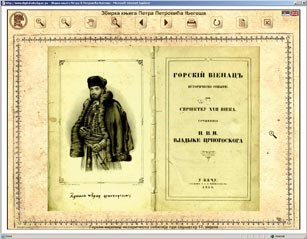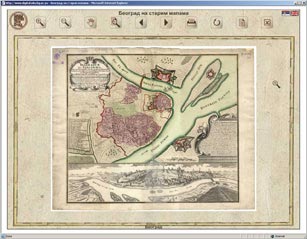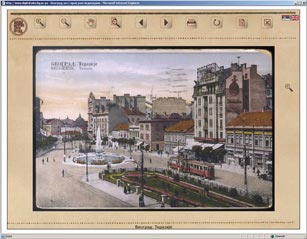New age
DIGITIZATION OF CULTURAL AND SCIENTIFIC HERITAGE OF SERBIA
A virtual treasury of spiritual heritage
Even if the National center for digitization still does not have an official status, and it is decisively getting the status of a NGO, this extremely important strategic work is developing. We already have enormous funds of old Cyrillic manuscripts, the most beautiful illuminated editions, rare books, collections of newspapers and magazines, cartography, engravings and art material, photographic documentation, printed music, catalogues, bibliographies available on the internet
By: Ljiljana Bogdanović
 One can comfortably cruise through the authentic pages of Miroslav’s (12th century) and Radoslav’s Gospel (15th century) sitting in an armchair at home, in slippers, these invaluable Cyrillic manuscripts, or maybe the Feast Menaion of Božidar Vuković, printed on parchment in 1537, which disappeared in the time of evacuation of the National Library in World War I and then found its place in the famous library of Sir Chester Beatty in Dublin in the summer of 1966. One can comfortably cruise through the authentic pages of Miroslav’s (12th century) and Radoslav’s Gospel (15th century) sitting in an armchair at home, in slippers, these invaluable Cyrillic manuscripts, or maybe the Feast Menaion of Božidar Vuković, printed on parchment in 1537, which disappeared in the time of evacuation of the National Library in World War I and then found its place in the famous library of Sir Chester Beatty in Dublin in the summer of 1966.
One can also walk the area of the Roman town Viminacium, built in the 1st century on the bank of Danube or the Monastery Kalenić (15th century), one of the most luxurious Serbian medieval monasteries where you can even peep into the inaccessible area behind the altar... Among those challenges one can see Groman’s Photo Album of Belgrade and Serbia in the 19th century, from the time when photography was born across the world or the copy of the ”general-staff map”, the first military map in Serbia, printed in 1894...
For those and all other adventures, maybe much more attractive, you cannot qualify by looking at some serious TV documentary or obeying the rules of a funny domestic version of ”Matrix”, but only by deciding to walk into domestic web-location, through you own computer, as a virtual visitor.
Without any advanced internet accessories — on www.ncd.matf.bg.ac.yu, www.mi.sanu.ac.yu or www.digital.nbs.bg.ac.yu — one can enter the magnificent trust of our ancestors. Those internet pages, protected by emblems of important institutions of science and culture (Serbian Academy of Sciences and Arts, National Library of Serbia and the Faculty of Mathematics) open the doors of a fascinating virtual treasury of Serbian spiritual heritage. Experts, and especially those who have transformed different kinds of materials into an electronic shape, mark this as a ”starting result”. This result seems convincing and ready for a mission of ”proving the presence and the continuity of a nation in space and time”.
MORE THAN IMAGINATION  The experts say that the digitization of heritage does not consider only a ”binary adaptation” of the contents which exist in form of books, images, documents, archive documents, audio and video notes, moveable or immobile objects, making sense of the thrilling non-professional belief that ”it all goes quick and simple”. It is a complex process of developing a planned network of informational systems, respecting suitable methodological and technological aspects, strategies and standards, wider media and professional presentation. Scanning, direct transforming into digital shape that is, is only one of the segments of processing. No matter how messed up this protocol seems to us, the thrilled consumers are only ”counting” the fantastic ”result”, the gift of the informatics era which gave more than its imagination for the popularization and the exchange of cultural heritage! The experts say that the digitization of heritage does not consider only a ”binary adaptation” of the contents which exist in form of books, images, documents, archive documents, audio and video notes, moveable or immobile objects, making sense of the thrilling non-professional belief that ”it all goes quick and simple”. It is a complex process of developing a planned network of informational systems, respecting suitable methodological and technological aspects, strategies and standards, wider media and professional presentation. Scanning, direct transforming into digital shape that is, is only one of the segments of processing. No matter how messed up this protocol seems to us, the thrilled consumers are only ”counting” the fantastic ”result”, the gift of the informatics era which gave more than its imagination for the popularization and the exchange of cultural heritage!
As an imperative of modern digitally shaped era, electronic presentation of cultural heritage is rapidly created in most of European and other well-developed countries. Some countries, like Finland or Czech Republic, have digitized almost a half of their cultural heritage. In Serbia, the digitization of spiritual heritage is developing in years, not as a public business but as a mission full of great energy, spirit and enthusiasm of a group of experts from the field of accounting but experts from artistic, cultural and scientific institutions. Many call this an example of great collaboration between science and culture, a model of domestic creative symbiosis for the 21st century.
Gathered in a respectable association, which is not yet established, but very hard working, called the Belgrade National Center for Digitization, the experts work, as they say, ”for hobby”, ”passion” or ”because of insomnia”. The quoted should not be lost in translation. They still wait for the public answer on an appeal of experts. It was requested that this field is systematically arranged and with engaging ministries of culture and science to formally establish the National Center for Digitization as a strategic body on the level of the Republic of Serbia. This body is necessary because there are 1500 domestic cultural associations which showed great interest and good mood for digitalizing heritage but also because there is a lack of personnel qualified for this kind of project.
NEW STRATEGIC SERIOUSNESS Since 2002, when representatives of the most famous institutions of science and culture (Archaeological Institute SANU, Serbian Archive, Faculty of Mathematics in Belgrade, Mathematical Institute SANU, National Library of Serbia, National Museum, Institute for the Protection of Cultural Monuments of Serbia, Yugoslav Film Archive and Matica Srpska) have signed the idea for the Center and the establishment of digitization, high political authorities didn’t seem to be in a hurry to give an official status, on the level of the state, to the institution which ”doesn’t want to be a non-governmental organization”.
Even if we are very late, the National Center for Digitization is using the ”fuel” of enthusiasm, individual steps and personal connection with the world which we have already mentioned, making steps forward, establishing contacts, working hard, with the attention of international experts – says Miomir Korać (Ph.D.) from the Archaeological Institute SANU (a pioneer institution in digitalizing the heritage) for the National Review. Our collocutor is the author of a successful electronic presentation of a world wide important archaeological locality Viminacium, and the recent assistant of the actual Minister of culture, predicting a much better future for the Center’s work.
We organize regular annual meetings, true international collaborations, publishing a serious magazine and realizing fantastic projects such as the Digitization of the manuscript of the Patriarchate of Peć, the Electronic catalogue on immobile cultural property, Standards for describing moveable cultural property... Besides the Center’s Committee, a Committee for Digitization was established in 2006 as a part of the Commission for collaborating between Serbia and UNESCO - says Korać.
In digitalizing the heritage in Serbia the biggest work was done by the National Library, the third library in Europe for the number of digitized old manuscripts. The leading institution of a kind made an impressive international collaboration in that field as well.
A MODEL FOR THE 21ST CENTURY  The digital library of the National Library of Serbia is based on principles of a free access to knowledge and information – says Tamara Butigan, the chief of the Department for the development of the digital library. – In this field we keep the pace with European libraries. Users are offered about half a million digital documents organized in more than 40 digital collections on the web page www.digital.nbs.bg.ac.yu. Collections are made by types of contents: Cyrillic manuscripts, Old and the rare book, Books, Papers and magazines, Cartographic materials, Engravings and art material, Photographic materials, Printed music and sound records, Catalogues, Bibliography. The biggest collection is the collection of the newspaper Politika. The period from 1904 to 1914 is available online with the support of the newspaper Politika. The most valuable collection is the one of hand written books (available online). These collections are completely digitized and they can be seen in the National Library. The digital library of the National Library of Serbia is based on principles of a free access to knowledge and information – says Tamara Butigan, the chief of the Department for the development of the digital library. – In this field we keep the pace with European libraries. Users are offered about half a million digital documents organized in more than 40 digital collections on the web page www.digital.nbs.bg.ac.yu. Collections are made by types of contents: Cyrillic manuscripts, Old and the rare book, Books, Papers and magazines, Cartographic materials, Engravings and art material, Photographic materials, Printed music and sound records, Catalogues, Bibliography. The biggest collection is the collection of the newspaper Politika. The period from 1904 to 1914 is available online with the support of the newspaper Politika. The most valuable collection is the one of hand written books (available online). These collections are completely digitized and they can be seen in the National Library.
Our first collection is the Serbian Children's Digital Library, including 130 most beautiful editions in Serbian. These digital books are available online with the agreement of the author and the publisher.
Even if experts cite (in explaining big strategic importance and practical advantages) the arguments such as the protection and the permanent storing of cultural property and the obligation towards future generations, it seems like the mentioned ”online available information” are the main goal of this project. The possibility of more high-quality studying and completing funds is very important for the development of science – using a 3D scanner, a presentation of monuments and other cultural objects, overcoming the most detailed descriptions – as well as the gain of the public is incomparable. The digital translation of any valuable contents from the fund of cultural heritage is a new experience, with no equal in history. Concepts of elite culture and exclusiveness of hermetic contests are getting a new meaning for a selected audience. Utopists and other people who would like to make the world happy couldn’t even dream of such a project!
***
In a European library
There are 10 digital collections from Serbia on the Portal of the European library. Eight collections are from the Digital National Library of Serbia. The National Library became a member of the project of European Library on July 1, 2005. Even if this project is completed, the collaboration between the National Library of Serbia and the project’s offices is continued in all ways. The web statistics say: over 20,000 users every month visit the digital library, and since the beginning of 2007 there were 110,000 visits.
***
The miracles of a virtual reading room
Among rare and old book and manuscripts, in a large and valuable collection inherited by the library of the Faculty of Mathematics in Belgrade, there are titles of which there are only a few copies left across the world. About 500 science books and other texts (fields of mathematics, mechanics, astronomy, physics...) published in the 19th century are not only a representative national but cultural heritage as well.
The digitization of a unique collection is first-class work. This project is led by Žarko Mijajlović (Ph.D.) from the Faculty of Mathematics with his 10 assistants. A part of the heritage which was digitized can be seen on the web site of the Center under the name of ”Virtual library”.
Someone had to do this – says Mijajlović, proud of his ”virtual reading room” where visitors can find a sensational content: three completed volumes of Elementorum Universae Matheoseos by Ruđer Bošković (printed in Venice, 1757), Aritmethics by Vasilije Damjanovič (1767) and Čislenica by Jovan Došenović (Budapest, 1809, the first book printed in Belgrade). This is also a place for studying 50 digitized doctoral dissertations (chosen from a large fund) written in the last few centuries by our elite: Mihailo Petrović, Mladen Berić, Petar Vukićević, Bogdan Gavrilović, Đuro Kurepa, Konstanti Orlov...
***
Vuk’s comments on Vuk’s dictionary
The president of the first formal body for digitization in Serbia - Committee as a part of the Commission for collaborating between Serbia and UNESCO, Zoran Ognjanović from the Mathematical Institute SANU, gives us a selection of places we must visit through the virtual walk on the site of the Institute:
We have completely digitized the notebooks and bases of all important mathematical magazines which were ever printed in Serbia. There is the Catalogue of immobile cultural property – a pioneer work from this field. We are about to finish the scanning of the oldest mathematic book of Serbia Aritmethics by Vasilije Damjanović (the collection of Matica Srpska) as well as the digital processing of Vuk’s copy of Vuk’s dictionary form 1918. One who would like to see how Vuk Karadžić made comments on the margins of this valuable edition now knows where he can fulfill his wish...
|
